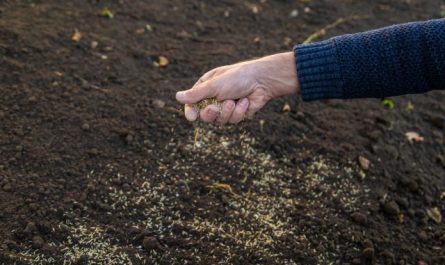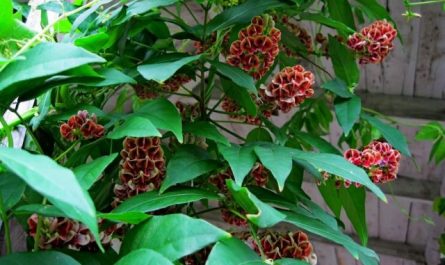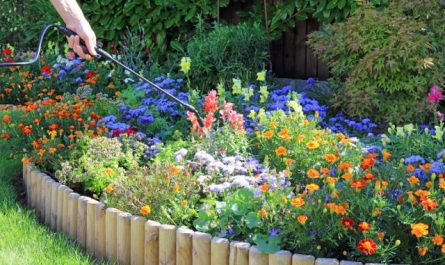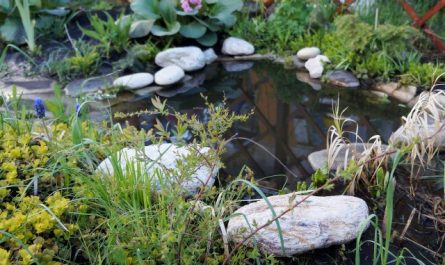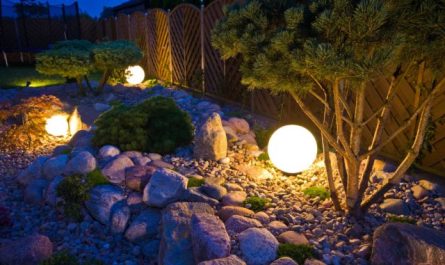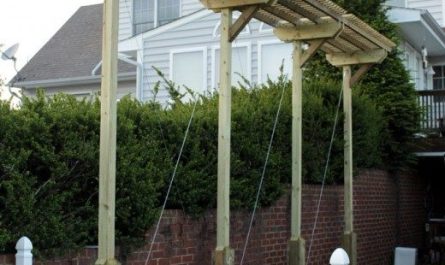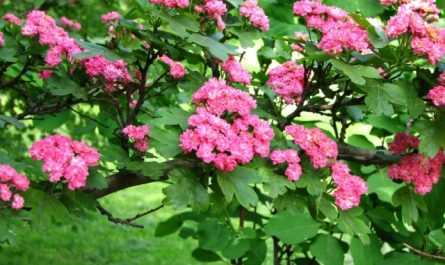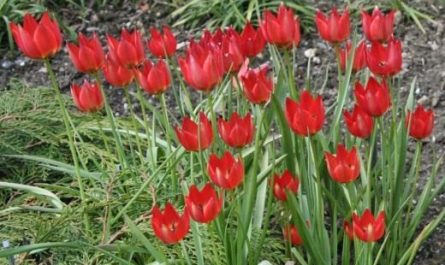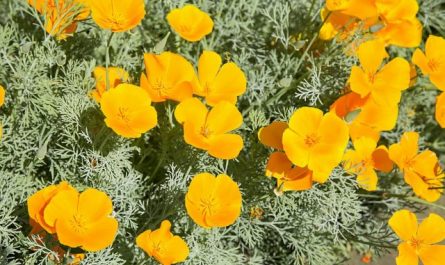Annuals. Biennials.
Annuals.
These plants are called annuals, or summer plants, because they live only one year.. Many of them require a long period of development, so they are grown as seedlings. Many annuals bloom all summer long – this includes petunia, tobacco. Other annuals have their seeds sown directly into the ground – calendula, cosmos, cornflower, nasturtium.

© DominusVobiscum
Summer flowers are mainly propagated by seeds. Terry varieties of nasturtium and petunia do not produce seeds. They are propagated by cuttings.
Summer flowers look beautiful in flowerbeds and borders. Among them there are plants with fragrant flowers. Sweet pea, mignonette, alyssum, stock – they will not only decorate the garden plot, but also fill it with a unique aroma.
Alissum
The plant is undemanding to heat and soil, can tolerate frost and drought, and grows well in shady places.
In early April, alyssum seeds are sown in boxes, and in May they are transplanted into open ground in a permanent place with a distance of 15-20 cm between plants. The plant will bloom until the frosts. You just need to loosen the soil in time, weed out the weeds and feed it.
Varieties of Alyssum maritima have white and purple flowers with a honey aroma.

© Noumenon
Aster
Annual aster is one of the most popular plants. Such asters reproduce only by seeds. By height, plants are divided into three groups. Tall – 50-80 cm, medium – 30-50 cm, low – up to 30 cm.
To make asters bloom early, they are grown in a greenhouse or a box. Seeds are sown in mid-March. For sowing, use only fresh soil (unused). Take 3 parts of turf soil, 1 part of sand and 1 part of well-weathered peat. After the soil has been well watered, add river or well-washed coarse-grained sand on top in a layer of 1,5-2 cm.
The seeds germinate at a temperature of 20-22°. The shoots appear in about a week. 1-2 g of seeds are needed per 5 m6 of the box. After sowing, the boxes are sprinkled with sand in a 0,5 cm layer and watered from a watering can with a fine sieve. The boxes should be covered with film to maintain uniform moisture. When the shoots appear, the temperature should be 15-16° C, at night it is better to reduce the temperature to 4° C. The seedlings should be watered well, but rarely, the soil should not be over-moistened. If a disease appears – black leg, then the plants are watered with water to which potassium permanganate has been added until a rich pink color.

© Ian Muttoo
When the seedlings get stronger, they are fed. The seedlings are picked when they have 1-2 true leaves. Approximately 7-10 days after rooting, the seedlings are fed with mullein infusion: 0,5 l per bucket of water. The seedlings are usually fed twice.
It is impossible to grow asters in one place for several years in a row, as they will be severely affected by fusarium. In the central part of our country, seedlings are usually planted in mid-May. Low varieties are planted at a distance of 20×20 cm, medium ones – 25×25 cm, high ones – 30x cm.
After planting, the seedlings are watered (approximately 0,5 liters of water per plant), then the soil is loosened and dry soil or weathered peat is added to the roots to prevent a crust from forming.
Asters can be fed with organic fertilizers on soils with insufficient humus content. On fertile soils, they are fed with an infusion of bird droppings.
You can sow asters in the ground and with seeds. Such plants will be more resistant to bad weather.
As soon as the soil is ripe, you can sow asters. The seeds are sown on the bed in furrows of 1,5-2 cm, after sowing the beds are watered from a watering can with a fine sieve. Then the crops are mulched with humus or fertile soil, the furrows are not sealed. The beds are watered only in windy, dry weather 1-2 times in 10-12 days.
You can also sow asters in the winter. The seeds are sown in prepared beds with furrows 2 cm deep (in the second half of November). The sowing is mulched with humus in a layer of 2-2,5 cm, weathered peat, which are stored in a frost-free room. The layer width is 5 cm. In the spring, without waiting for shoots, focusing on the mulch layer, you can loosen the space between the rows.
The seedlings are thinned out when the first true leaf appears. On poor light soils, asters are fed with mullein. Before fertilizing, the area is watered. The area should be evenly moistened. Weeds should be removed in a timely manner. Asters are loosened near the plants by only 2-3 cm, their root system is located close to the soil. The depth between the rows is 5-7 cm.
In autumn, asters can be transplanted into flower pots, and they will continue to delight you with their flowering for a long time.

© anniesannuals
Calendula
This unpretentious plant likes to grow in sunny places where the soil is well fertilized and moist.
Propagated by seeds, which can be sown in the ground in autumn or spring, and by self-seeding. To obtain seedlings, seeds are sown in April, planted in the ground at the end of May, the distance between plants is 15-30 cm (depending on the variety).
Flower color ranges from yellow to orange, from simple to densely double.
It blooms in 45-50 days, flowering lasts from the end of June until frost.
Seeds are collected from calendula when they have turned yellow and brown.

© Carl E Lewis
Nasturtium
Nasturtium loves light, grows well in soils without fertilizers, containing a large amount of nitrogen. Nasturtium is propagated by seeds, which ripen in August – September.
In early May, nasturtium seeds are sown in the ground, shoots will appear in 12 days, the plant will bloom in 45-50 days. When the plant has two or three true leaves, the shoots need to be thinned out. For climbing varieties, a large feeding area of 70 X 35 cm is needed, for bush varieties – 70X 20 cm, or 35X 40 cm.
Nasturtium varieties differ in plant height, leaf and flower color. According to “growth” they are divided into bushy ones with a height of 20-30 cm, climbing ones – 2-4 m whip length. Leaves can be light green, green, dark green. They can be large, medium and small. Flower coloring ranges from pink on a cream background to dark burgundy, almost black and dark brown, from cream to dark yellow. Flowers can be simple and double.
Nasturtium does not tolerate high and low temperatures well.

© Carl E Lewis
Marigold
Marigolds, or tagetes, can be single (simple), semi-double, and double. Most often, marigolds come in two colors – red with a yellow border, yellow or orange with a brown spot.
Marigolds love warmth and light, but are not demanding to the soil and can tolerate both drought and excess moisture.
It is better to grow them as seedlings. The seeds are sown in April, then the seedlings are pricked out, as they quickly stretch out due to lack of light. They are planted in the ground at the end of May – in June. Tall varieties – 30-50 cm between plants, low – 20-25 cm.
Marigolds can be sown directly into open ground; they bloom in 45–70 days, depending on the variety..

© Carl E Lewis
Sweet pea
Sweet pea is the most popular and widespread among annuals.
The soil for sweet peas is prepared in the fall. Lime is added (0,2 kg per 1 m2), organic fertilizers or peat (1 kg per 1 m2), and on heavy clay soils sand is added (6 kg per 1 m2). Then the soil is dug up.
Sweet peas love light and are not afraid of frost. They especially love moderate temperatures. At low temperatures and with sharp fluctuations, sweet peas lose their flowers and buds.
The plant can be grown using seedlings or by sowing seeds directly into the soil. For seedlings, seeds are sown in late March – early April. Water the plants moderately as soon as the soil dries out. When the plant has 3-4 true leaves, pinch off the growth point and feed the plants.
As soon as the soil warms up, peas are immediately planted in the ground with a distance of 15-20 cm between plants.
If you sow the seeds in the ground, the peas will bloom in 70-90 days.
The care for the plants is as follows: they are fed twice – 1,5-2 weeks after germination or planting of seedlings and before budding, the soil is loosened, and weeds are removed.

© lirialove
Cosmey
This plant is unpretentious, cold-resistant and light-loving. It is not necessary to fertilize the soil with organic fertilizers, flowering is delayed, and the plant blooms less abundantly. The height of the cosmos is from 1 to 1,2 m with strongly dissected decorative foliage. Florists grow, or, more precisely, work with two species – cosmos sulphurous and cosmos bipinnate. Cosmos bipinnate can be white, pink and crimson. The color of cosmos sulphurous is golden and orange.
Seeds are sown into the soil when the soil warms up (seedlings are also possible). The distance between plants is 20-30 cm. It blooms in 45-50 days and blooms until frost. The seeds are collected when they turn brown.

© Carl E Lewis
Carnation
One of the most popular plants grown in the garden. Among carnations there are perennials and biennials, some of which are grown as annuals. The annuals include the garden carnation and the Chinese carnation. In the central zone of the country, the garden carnation blooms only at the end of August, it needs a lot of heat, so flower growers grow the Chinese carnation, or rather its variety, the Neddewig carnation. The height of the plants is from 20-30 cm, the color is single-color or two-color.
This is a light-loving and cold-resistant plant that does not tolerate excess moisture.
To make the plant bloom in early summer, the seeds need to be sown in March. Then the seedlings are pricked out.

© knguyenpvn
In mid-May, seedlings are planted in the ground at a distance of 20 cm between plants, in a sunny area, seasoned with organic fertilizers. Plants that were grown in peat pots take root especially well. Plants are fed with organic fertilizers, the soil is loosened, weeds are removed.
Annual plants at “Botanichka”
Biannuals

© RATAEDL
These are plants that produce the most beautiful flowers in the second year after sowing the seeds. Some of these plants are perennials, but in the Non-Black Earth Region they are grown as biennials, since in the third year they usually suffer greatly from frost. Their flowers become worse (smaller, not as bright). If the seeds of these plants are sown early, they will bloom this year.
Biennials bloom in spring and early summer.
Pansies
Pansies, or Viola, Vitrockian violet. This is a complex hybrid, in which the wild pansy, horned violet, Altai violet and yellow violet participated.
Pansies are undemanding to the soil. They bloom well when rotted manure and compost are added to the soil. These are shade-tolerant plants, they are not afraid of the cold, they only need to be slightly covered for the winter. They do not tolerate excess moisture well; in dry and hot weather, the flowers become smaller and bloom poorly. Like most biennials, many plants die or lose their decorative qualities in the third year.
Pansies are propagated by seeds and cuttings. To make the plants bloom in the first year, the seeds are sown in March-April. In May, they are planted in open ground. To make the plants bloom in the second year in the spring, the seeds are sown in a permanent place in the ground in early July. The crops should not be thickened.
In summer, when there is a lack of moisture, plants are watered, weeded, loosened and fed with diluted mullein.

© chätzle
Bell
Plants are 60-90 cm tall. Flowers are white, lilac, pink, blue, purple. They love fertile soils that have been added with lime. The seeds are sown in ridges. If sown early, they will bloom the same year. A month after sowing, the seedlings are pricked out at a distance of 5 cm from each other. At the end of August, they are transplanted to a permanent place with an area of 40 X 40 cm.
Can be propagated by dividing the bush and root suckers.

© Kpjas
Mallow
Mallow, or hollyhock, is a tall plant (up to 2 m), with large, semi-double and double flowers. Color – white, pink, red, purple, black, yellow. Flowers are located on a long flower bone. It begins to bloom from June until late autumn.
Mallow blooms abundantly in well-fertilized soil. Plants are fed (with bird droppings) at the beginning of flowering.
Propagated by seeds. If sown early, they bloom in the first year. Usually, seeds are sown in the fall, and plants are planted in the spring at a distance of 40-60 cm from each other.

© in pastel
Daisy
The height of the plant is from 10 to 30 cm. The flowers are white, red, pink. They bloom from April to June, in rainy summers – until July, they tolerate winter well, keeping leaves and buds under the snow. They reproduce by seeds and dividing the bush. But more powerful and abundantly flowering plants grow from seeds.
Daisy is not afraid of shade, grows well in any soil, but responds well to the introduction of organic fertilizers. It tolerates transplantation at any time.
Daisy seeds are very small, so they are covered with a thin layer of sifted soil or peat. To prevent the soil from drying out, the crops need to be slightly shaded. The soil should be loose and nutritious. In August – September, the plants can be planted in a permanent place at a distance of 20 cm from each other. In this case, the plants will bloom the following year.

© Morgaine
To get daisies to bloom in the fall, the seeds need to be sown in late March or early April. Make sure that the soil is always loose and the plants are watered moderately. Plants can be fed with organic fertilizers 1-2 times.
Materials used:
- Garden. Vegetable garden. Estate: Almost an encyclopedia for beginners. T. I. Golovanova, G. P. Rudakov.



